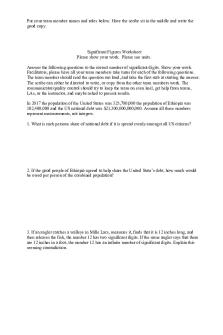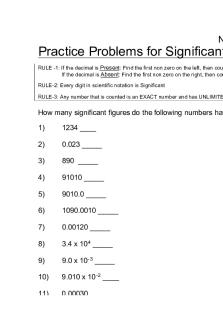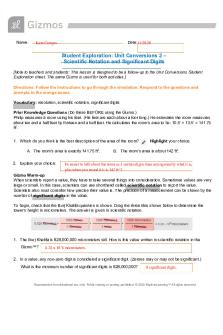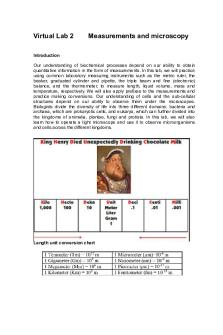Lab Summary - Measurements & Sig Figs PDF

| Title | Lab Summary - Measurements & Sig Figs |
|---|---|
| Course | General Chemistry 1 |
| Institution | Broward College |
| Pages | 5 |
| File Size | 142.4 KB |
| File Type | |
| Total Downloads | 36 |
| Total Views | 162 |
Summary
This is a practice assignment for general chemistry 1...
Description
Measurements and Sig Figs Lab Summery
Abstract It is important to read all labware to the appropriate significant figures. Significant figures convey the ___precision___ (accuracy or precision) of the measured quantity. When measurements are used in calculations, it is the number with the ___fewest___ (most or fewest) significant figures that will determine how many significant figures are in the product or quotient. The significant figures of a sum or difference will be determined by the number with the __ least ___ (greatest or least) precision.
Several pieces of lab ware were used, and the precision was analyzed for each item. The scale is digital and __ all ___ (all or some) of the digits should be recorded for every __ mass ___ (mass, volume, temperature, o density). The thermometer should be read to the nearest __0.1___ C. The metric ruler is calibrated to the nearest __0.01___ cm. When reading the length of an object in centimeters, the __ hundredths ___ (ones, tenths, hundredths, thousandths) place should be estimated. That is the digit of uncertainty. The 10mL graduated cylinder should be read to the nearest __0.1___ mL. The __50___ (25 or 50) mL graduated cylinder should be read to the nearest __0.1___ mL. A beaker is the __least___ (most or least) precise piece of volume measuring labware required for this course and should only be used to estimate volume. The precision of the 10mL graduated cylinder was demonstrated by comparing the theoretical volume of water found by using tabulated density values and the mass of water and the experimental volume of water found by reading the labware. A __3.2___ % difference was found in these values.
The density of __paperclip___ (identify the object you used to determine density) was found to be __9___ g/mL. This density was found by __dividing___ (adding, subtracting, multiplying, dividing) the mass of the __ paperclip ___ (object name), __2.77 ___ g, by the volume found by displacement, __0.3___ mL. The density is limited to ___1__ (number) of significant figures because the __volume___ (mass or volume) has __1___ (number) significant figures. Since this value is found by __ dividing ___ (adding, subtracting, multiplying, dividing), it is restricted to the __basic mass and length measurements that volume comes from__ (finish this sentence).
Data Table 1: Measuring Mass Object
Mass (g)
Thumbtack Paperclip INSERT A PICTURE of the scale with one of your objects on the scale. Be sure the read out on the scale is visible. Include your ID in the picture.
Data Table 2: Measuring Temperature Qualitative description of water
Temperature recorded (oC)
Room Temp water Cold Water
Data Table 3: Measuring Length Qualitative description of object
Length in mm
Length in cm
Length in m
Paperclip
m
m
Thumbtack
m
Data Table 4: Measuring Volume and Mass. (1) (2) (3) (4) (5) (6) (7) (8)
(9)
Mass of empty 10mL graduated cylinder: Mass of 10mL cylinder with water in it Volume reading to the correct significant figures Mass of just the water (2) - (1) = (4) Temperature of the room temperature water, from above. Density from the table
g g
g o
Calculated theoretical volume (4) / (6) = (7) Percent difference between theoretical volume and experimental volume. ((7) - (3)) / (7) * 100 = (8)
Volume reading of above water in the 50mL Graduated Cylinder to the correct significant figures (10) Percent difference between theoretical volume and experimental volume. ((7) - (9)) / (7) * 100 = (10)
L
1
0
L
Data Table 5: Measuring Density 1.
Mass of Object: Paperclip
2.
Volume of water initial reading
3.
Volume of water with paperclip final
4.
Water displaced 3mL final volume –
5.
3 mL volume of object 0 mL initial volume =
Density of the object D=V/M g / 0 3 mL =
g/mL
Discussion – (The discussion section should explain the results. In some cases in this course, you will be asked specific questions that are related to the data and interpretation of concepts.)
The measuring mass section of this lab allowed for the initial set up of the scale to be used for this course and practice recording mass in grams. The objects measured were __paperclip___ (object 1) with a mass of __ _ and __thumbtack___ (object 2) with a mass of __0 7 ___ g.
The measuring temperature section of this lab introduced the thermometer that will be used for this course.
o
When recording the temperature in this course, all readings should be recorded to the nearest ___ __ C. o Room temperature water was found to have a temperature of __ 9___ C and __iced___ (hot or iced) water o was found to have a temperature of __ ___ C.
The length measuring section of this lab allowed for practice of measuring with a metric ruler. A(n) __paperclip___ (object 1) with a length of __ ___ cm and __thumbtack___ (object 2) with a length of __ ___ cm were used in this portion of the lab. The units were converted to millimeters and meters by the following calculations: _insert your calculations for how you converted between units for one of your measurements. This may be typed or a picture of handwritten work._
The volume measuring portion of the lab included taking the mass of clean, dry labware, filled labware, as well as reading liquid volumes with the calibrations on the side of the labware. The 10mL graduated cylinder was found to have calibrations at every __0.1___ (0.1, 0.2) mL. When between 9.5-10mL of water was measured in the 10mL graduated cylinder, that volume was read to be __10.0___ mL. When the same water was poured into the __50___ (25 or 50)mL cylinder, it was read to be __10.0___ mL. It is assumed that all of the water was poured from one cylinder to the other and no droplets were left to adhere to the walls of the cylinders. The mass of the dry 10mL graduated cylinder was found to be __ ___ g (initial mass). The 10mL graduated cylinder with the __10.0___ mL of water in it was found to have a mass of __ ___ g (final mass). Subtracting the empty graduated cylinder (initial mass) from the laden graduated cylinder (final mass) yields the mass of the water. This is called finding the mass by difference. The mass of the water was __ ___ g ___1
7__ g (final mass) - __
___ g (initial mass) = ___10
__ g (mass of the water)...
Similar Free PDFs

Chapter 1 sig figs - assignment
- 2 Pages

Practice problems for Sig Figs
- 2 Pages

Chemistry Lab 1 Measurements
- 5 Pages

Chem Lab 2: Metric Measurements
- 5 Pages

SIG - Début de cours de SIG
- 2 Pages

SIG participatifs
- 1 Pages
Popular Institutions
- Tinajero National High School - Annex
- Politeknik Caltex Riau
- Yokohama City University
- SGT University
- University of Al-Qadisiyah
- Divine Word College of Vigan
- Techniek College Rotterdam
- Universidade de Santiago
- Universiti Teknologi MARA Cawangan Johor Kampus Pasir Gudang
- Poltekkes Kemenkes Yogyakarta
- Baguio City National High School
- Colegio san marcos
- preparatoria uno
- Centro de Bachillerato Tecnológico Industrial y de Servicios No. 107
- Dalian Maritime University
- Quang Trung Secondary School
- Colegio Tecnológico en Informática
- Corporación Regional de Educación Superior
- Grupo CEDVA
- Dar Al Uloom University
- Centro de Estudios Preuniversitarios de la Universidad Nacional de Ingeniería
- 上智大学
- Aakash International School, Nuna Majara
- San Felipe Neri Catholic School
- Kang Chiao International School - New Taipei City
- Misamis Occidental National High School
- Institución Educativa Escuela Normal Juan Ladrilleros
- Kolehiyo ng Pantukan
- Batanes State College
- Instituto Continental
- Sekolah Menengah Kejuruan Kesehatan Kaltara (Tarakan)
- Colegio de La Inmaculada Concepcion - Cebu









